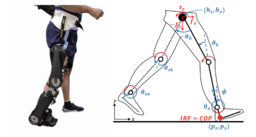Total Energy Shaping for Task-Invariant Control of Exoskeletons
TECHNOLOGY NUMBER: 2021-180

OVERVIEW
A means to provide body weight support for patients undergoing gait training following neurologic dysfunction- A control methodology to provide trajectory-free, consistent assistance across all locomotive activities
- An exoskeleton control strategy for augmenting step length and linear velocity via energy shaping
BACKGROUND
In clinical settings that require gait rehabilitation for patients who have suffered neurologic disabilities due to stroke or spinal cord injuries, current robotic exoskeletons are limited by an approach that enforces pre-defined joint patterns that are task-specific and user-dependent. To incorporate different locomotor tasks, these exoskeletons have to recognize the subject's intent to switch control modes within a limited set of options. The limited number of options prevents these devices from accommodating varying daily activities, and misclassification or faulty detections of transition events can cause falls. For instance, in human walking, contact varies from heel to toe resulting in multiple periods of underactuation, which cannot be captured by the existing framework. Moreover, the tendencies for these rehabilitation aids to reinforce reference trajectories replicates normative joint kinematics but does not facilitate active learning. As such, the patient may become constrained in ways that lead them to fail in their attempts relearn their own natural walking gaits during training. So, a need exists for new, trajectory-free control methods that allow robotic exoskeletons to replicate joint kinematics while facilitating patient-specific kinematics.
INNOVATION
Researchers have invented a control methodology that provides trajectory-free, consistent assistance across all possible locomotion activities to patients undergoing gait rehabilitation. This innovation provides an exoskeletal control strategy for augmenting step length and step linear velocity via total energy shaping. The device also shapes the total mechanical energy of the combined human and exoskeleton system to permit the subject to feel acceleration and deceleration forces while walking more easily. The user can also more easily perceive the gravitational forces being exerted on their center of mass and lower extremities. Using simple anatomical measurements, this controller can be easily implemented on powered exoskeletons to allow gait training outside of clinical environments. Future evaluation of this technique will explore other possible forms of energy modification and establish possible passivity properties between the human user and the exoskeleton.